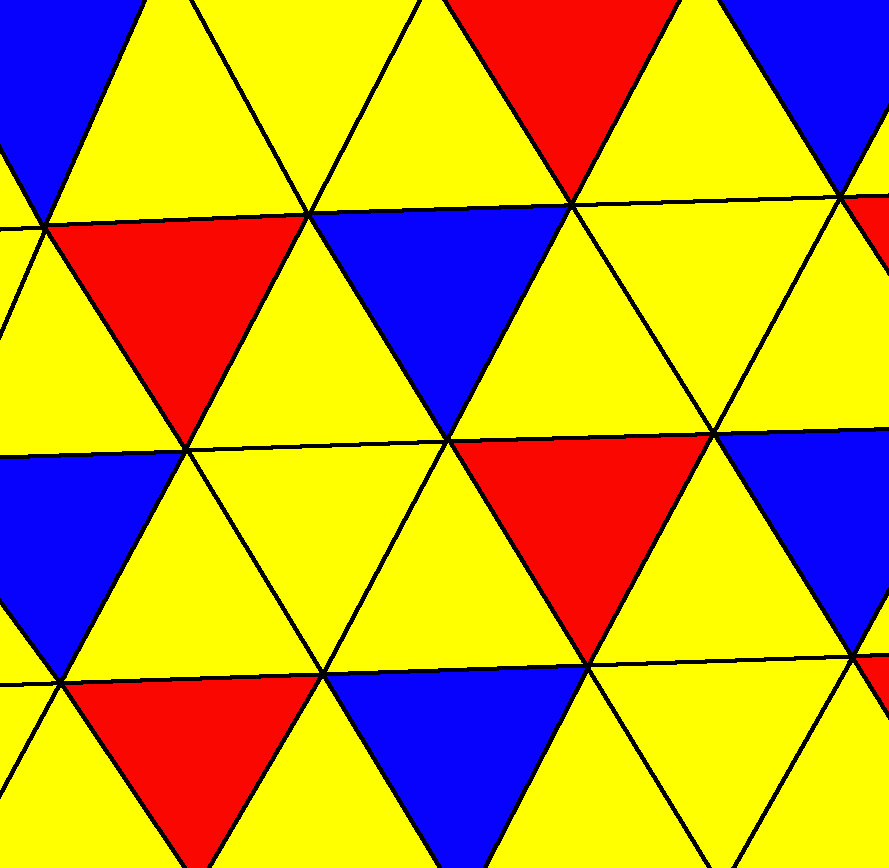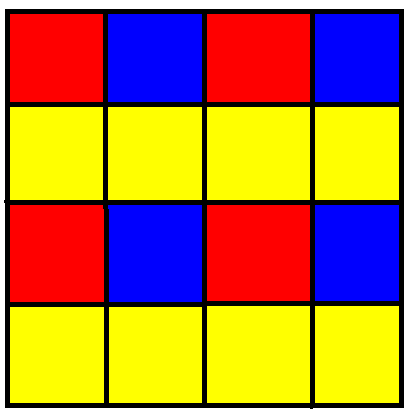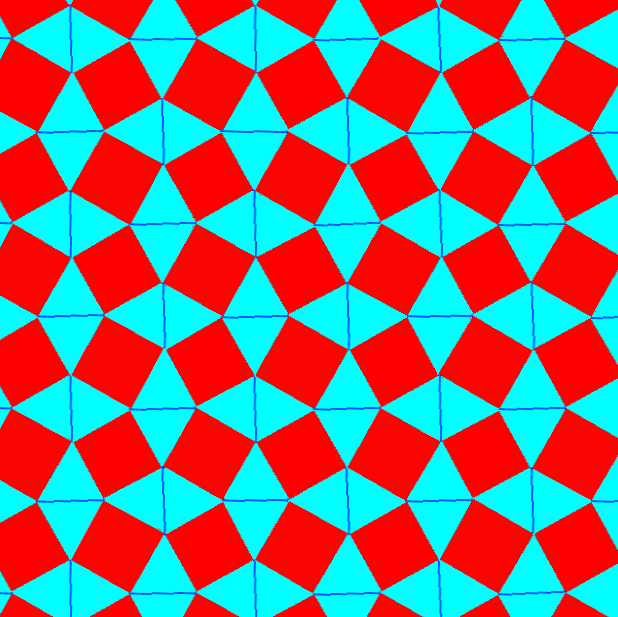List Of Uniform Tilings on:
[Wikipedia]
[Google]
[Amazon]
 This table shows the 11 convex
This table shows the 11 convex








 #
#







 #
#

 #
#
 #
#
 #
#
 #
# #
# #
# #
# #
#
Casey Mann at the University of Washington
* *
Uniform Tessellations on the Euclid plane
{{DEFAULTSORT:Euclidean uniform tilings
uniform tiling
In geometry, a uniform tiling is a tessellation of the plane by regular polygon faces with the restriction of being vertex-transitive.
Uniform tilings can exist in both the Euclidean plane and hyperbolic plane. Uniform tilings are related to the f ...
s (regular and semiregular) of the Euclidean plane
In mathematics, the Euclidean plane is a Euclidean space of dimension two. That is, a geometric setting in which two real quantities are required to determine the position of each point ( element of the plane), which includes affine notions of ...
, and their dual tilings.
There are three regular and eight semiregular tilings in the plane. The semiregular tilings form new tilings from their duals, each made from one type of irregular face.
John Conway
John Horton Conway (26 December 1937 – 11 April 2020) was an English mathematician active in the theory of finite groups, knot theory, number theory, combinatorial game theory and coding theory. He also made contributions to many branches ...
calls these uniform duals ''Catalan tilings'', in parallel to the Catalan solid
In mathematics, a Catalan solid, or Archimedean dual, is a dual polyhedron to an Archimedean solid. There are 13 Catalan solids. They are named for the Belgian mathematician Eugène Catalan, who first described them in 1865.
The Catalan sol ...
polyhedra.
Uniform tilings are listed by their vertex configuration
In geometry, a vertex configurationCrystallography ...
, the sequence of faces that exist on each vertex. For example ''4.8.8'' means one square and two octagons on a vertex.
These 11 uniform tilings have 32 different ''uniform coloring
In geometry, a uniform coloring is a property of a uniform figure (uniform tiling or uniform polyhedron) that is colored to be vertex-transitive. Different symmetries can be expressed on the same geometric figure with the faces following differ ...
s''. A uniform coloring allows identical sided polygons at a vertex to be colored differently, while still maintaining vertex-uniformity and transformational congruence between vertices. (Note: Some of the tiling images shown below are ''not'' color-uniform)
In addition to the 11 convex uniform tilings, there are also 14 known nonconvex tilings, using star polygon
In geometry, a star polygon is a type of non-convex polygon. Regular star polygons have been studied in depth; while star polygons in general appear not to have been formally defined, certain notable ones can arise through truncation operations ...
s, and reverse orientation vertex configurations. A further 28 uniform tilings are known using apeirogon
In geometry, an apeirogon () or infinite polygon is a generalized polygon with a countably infinite number of sides. Apeirogons are the two-dimensional case of infinite polytopes.
In some literature, the term "apeirogon" may refer only to the ...
s. If zigzags are also allowed, there are 23 more known uniform tilings and 10 more known families depending on a parameter: in 8 cases the parameter is continuous, and in the other 2 it is discrete. The set is not known to be complete.
Laves tilings
In the 1987 book, ''Tilings and Patterns'',Branko Grünbaum
Branko Grünbaum ( he, ברנקו גרונבאום; 2 October 1929 – 14 September 2018) was a Croatian-born mathematician of Jewish descentArchimedean solid
In geometry, an Archimedean solid is one of the 13 solids first enumerated by Archimedes. They are the convex uniform polyhedra composed of regular polygons meeting in identical vertices, excluding the five Platonic solids (which are composed ...
s. Their dual tilings are called ''Laves tilings'' in honor of crystallographer Fritz Laves
Fritz Henning Emil Paul Berndt Laves (27 February 1906 – 12 August 1978) was a German crystallographer who served as the president of the German Mineralogical Society from 1956 to 1958. He is the namesake of Laves phases and the Laves tiling ...
. They're also called Shubnikov–Laves tilings after Aleksei Shubnikov. John Conway
John Horton Conway (26 December 1937 – 11 April 2020) was an English mathematician active in the theory of finite groups, knot theory, number theory, combinatorial game theory and coding theory. He also made contributions to many branches ...
called the uniform duals ''Catalan tilings'', in parallel to the Catalan solid
In mathematics, a Catalan solid, or Archimedean dual, is a dual polyhedron to an Archimedean solid. There are 13 Catalan solids. They are named for the Belgian mathematician Eugène Catalan, who first described them in 1865.
The Catalan sol ...
polyhedra.
The Laves tilings have vertices at the centers of the regular polygons, and edges connecting centers of regular polygons that share an edge. The tiles
Tiles are usually thin, square or rectangular coverings manufactured from hard-wearing material such as ceramic, stone, metal, baked clay, or even glass. They are generally fixed in place in an array to cover roofs, floors, walls, edges, or o ...
of the Laves tilings are called '' planigons''. This includes the 3 regular tiles (triangle, square and hexagon) and 8 irregular ones. Each vertex has edges evenly spaced around it. Three dimensional analogues of the ''planigons'' are called stereohedrons.
These dual tilings are listed by their face configuration
In geometry, a vertex configurationCrystallography ...
, the number of faces at each vertex of a face. For example ''V4.8.8'' means isosceles triangle tiles with one corner with four triangles, and two corners containing eight triangles. The orientations of the vertex planigons (up to D12) are consistent with the vertex diagrams in the below sections.
Convex uniform tilings of the Euclidean plane
All reflectional forms can be made byWythoff construction
In geometry, a Wythoff construction, named after mathematician Willem Abraham Wythoff, is a method for constructing a uniform polyhedron or plane tiling. It is often referred to as Wythoff's kaleidoscopic construction.
Construction process
...
s, represented by Wythoff symbol
In geometry, the Wythoff symbol is a notation representing a Wythoff construction of a uniform polyhedron or plane tiling within a Schwarz triangle. It was first used by Coxeter, Longuet-Higgins and Miller in their enumeration of the uniform pol ...
s, or Coxeter-Dynkin diagrams, each operating upon one of three Schwarz triangle
In geometry, a Schwarz triangle, named after Hermann Schwarz, is a spherical triangle that can be used to tile a sphere (spherical tiling), possibly overlapping, through reflections in its edges. They were classified in .
These can be defined mor ...
(4,4,2), (6,3,2), or (3,3,3), with symmetry represented by Coxeter group
In mathematics, a Coxeter group, named after H. S. M. Coxeter, is an abstract group that admits a formal description in terms of reflections (or kaleidoscopic mirrors). Indeed, the finite Coxeter groups are precisely the finite Euclidean refl ...
s: ,4 ,3 or [3/sup>.html"_;"title=".html"_;"title="[3">[3/sup>">.html"_;"title="[3">[3/sup>_ [3/sup>.html"_;"title=".html"_;"title="[3">[3/sup>">.html"_;"title="[3">[3/sup>_Alternation_(geometry)">Alternated_forms_such_as_the_snub_can_also_be_represented_by_special_markups_within_each_system._Only_one_uniform_tiling_can't_be_constructed_by_a_Wythoff_process,_but_can_be_made_by_an_Elongation_(geometry).html" ;"title="Alternation_(geometry).html" ;"title="">[3/sup>.html" ;"title=".html" ;"title="[3">[3/sup>">.html" ;"title="[3">[3/sup> Alternation (geometry)">Alternated forms such as the snub can also be represented by special markups within each system. Only one uniform tiling can't be constructed by a Wythoff process, but can be made by an Elongation (geometry)">elongation of the triangular tiling. An orthogonal mirror construction [∞,2,∞] also exists, seen as two sets of parallel mirrors making a rectangular fundamental domain. If the domain is square, this symmetry can be doubled by a diagonal mirror into the ,4family.
Families:
* (4,4,2), , ,4– Symmetry of the regular square tiling
In geometry, the square tiling, square tessellation or square grid is a regular tiling of the Euclidean plane. It has Schläfli symbol of meaning it has 4 squares around every vertex.
Conway called it a quadrille.
The internal angle of the s ...
** , infin;,2,∞* (6,3,2), , ,3– Symmetry of the regular hexagonal tiling
In geometry, the hexagonal tiling or hexagonal tessellation is a regular tiling of the Euclidean plane, in which exactly three hexagons meet at each vertex. It has Schläfli symbol of or (as a truncated triangular tiling).
English mathemat ...
and triangular tiling
In geometry, the triangular tiling or triangular tessellation is one of the three regular tilings of the Euclidean plane, and is the only such tiling where the constituent shapes are not parallelogons. Because the internal angle of the equilater ...
.
** (3,3,3), , [3/sup>.html" ;"title=".html" ;"title="[3">[3/sup>">.html" ;"title="[3">[3/sup>The ,4group family
The ,3group family
Non-Wythoffian uniform tiling
Uniform colorings
There are a total of 32 uniform colorings of the 11 uniform tilings: #Triangular tiling – 9 uniform colorings, 4 wythoffian, 5 nonwythoffian #*





 #
#Square tiling
In geometry, the square tiling, square tessellation or square grid is a regular tiling of the Euclidean plane. It has Schläfli symbol of meaning it has 4 squares around every vertex.
Conway called it a quadrille.
The internal angle of the s ...
– 9 colorings: 7 wythoffian, 2 nonwythoffian
#* 






 #
#Hexagonal tiling
In geometry, the hexagonal tiling or hexagonal tessellation is a regular tiling of the Euclidean plane, in which exactly three hexagons meet at each vertex. It has Schläfli symbol of or (as a truncated triangular tiling).
English mathemat ...
– 3 colorings, all wythoffian
#* Trihexagonal tiling
In geometry, the trihexagonal tiling is one of 11 uniform tilings of the Euclidean plane by regular polygons. See in particular Theorem 2.1.3, p. 59 (classification of uniform tilings); Figure 2.1.5, p.63 (illustration of this tiling), Theorem 2. ...
– 2 colorings, both wythoffian
#*  #
#Snub square tiling
In geometry, the snub square tiling is a semiregular tiling of the Euclidean plane. There are three triangles and two squares on each vertex. Its Schläfli symbol is ''s''.
Conway calls it a snub quadrille, constructed by a snub operation applie ...
– 2 colorings, both alternated wythoffian
#* 
Truncated square tiling
In geometry, the truncated square tiling is a semiregular tiling, semiregular tiling by regular polygons of the Euclidean plane with one square (geometry), square and two octagons on each vertex (geometry), vertex. This is the only edge-to-edge ti ...
– 2 colorings, both wythoffian
#* Truncated hexagonal tiling
In geometry, the truncated hexagonal tiling is a semiregular tiling of the Euclidean plane. There are 2 dodecagons (12-sides) and one triangle on each vertex.
As the name implies this tiling is constructed by a truncation operation applies to a he ...
– 1 coloring, wythoffian
#* Rhombitrihexagonal tiling
In geometry, the rhombitrihexagonal tiling is a semiregular tiling of the Euclidean plane. There are one triangle, two squares, and one hexagon on each vertex. It has Schläfli symbol of rr.
John Conway calls it a rhombihexadeltille.Conway, 2 ...
– 1 coloring, wythoffian
#* Truncated trihexagonal tiling
In geometry, the truncated trihexagonal tiling is one of eight semiregular tilings of the Euclidean plane. There are one square, one hexagon, and one dodecagon on each vertex. It has Schläfli symbol of ''tr''.
Names
Uniform colorings
Th ...
– 1 coloring, wythoffian
#* Snub hexagonal tiling
In geometry, the snub hexagonal tiling (or ''snub trihexagonal tiling'') is a semiregular tiling of the Euclidean plane. There are four triangles and one hexagon on each vertex. It has Schläfli symbol ''sr''. The snub tetrahexagonal tiling is a ...
– 1 coloring, alternated wythoffian
#* Elongated triangular tiling
In geometry, the elongated triangular tiling is a semiregular tiling of the Euclidean plane. There are three triangles and two squares on each vertex. It is named as a triangular tiling elongated by rows of squares, and given Schläfli symbol :e. ...
– 1 coloring, nonwythoffian
#* 
See also
*List of tessellations
See also
*Uniform tiling
**Convex uniform honeycombs
**List of k-uniform tilings
**List of convex uniform tilings
**Uniform tilings in hyperbolic plane
{{DEFAULTSORT:Tessellations
Mathematics-related lists
Tessellation, * ...
* Euclidean tilings by convex regular polygons
Euclidean Plane (mathematics), plane Tessellation, tilings by convex regular polygons have been widely used since antiquity. The first systematic mathematical treatment was that of Johannes Kepler, Kepler in his ''Harmonices Mundi'' (Latin langua ...
* Uniform tilings in hyperbolic plane
In hyperbolic geometry, a uniform hyperbolic tiling (or regular, quasiregular or semiregular hyperbolic tiling) is an edge-to-edge filling of the hyperbolic plane which has regular polygons as faces and is vertex-transitive ( transitive on its v ...
* Convex uniform honeycomb
In geometry, a convex uniform honeycomb is a uniform polytope, uniform tessellation which fills three-dimensional Euclidean space with non-overlapping convex polyhedron, convex uniform polyhedron, uniform polyhedral cells.
Twenty-eight such honey ...
– The 28 uniform 3-dimensional tessellations, a parallel construction to the convex uniform Euclidean plane tilings.
* Percolation threshold
The percolation threshold is a mathematical concept in percolation theory that describes the formation of long-range connectivity in Randomness, random systems. Below the threshold a giant connected component (graph theory), connected component ...
References
Further reading
* * * (Section 2–3 ''Circle packings, plane tessellations, and networks'', pp. 34–40). *Casey Mann at the University of Washington
* *
External links
*Uniform Tessellations on the Euclid plane
{{DEFAULTSORT:Euclidean uniform tilings
Uniform
A uniform is a variety of clothing worn by members of an organization while participating in that organization's activity. Modern uniforms are most often worn by armed forces and paramilitary organizations such as police, emergency services, se ...
Uniform tilings
Uniform planar tilings